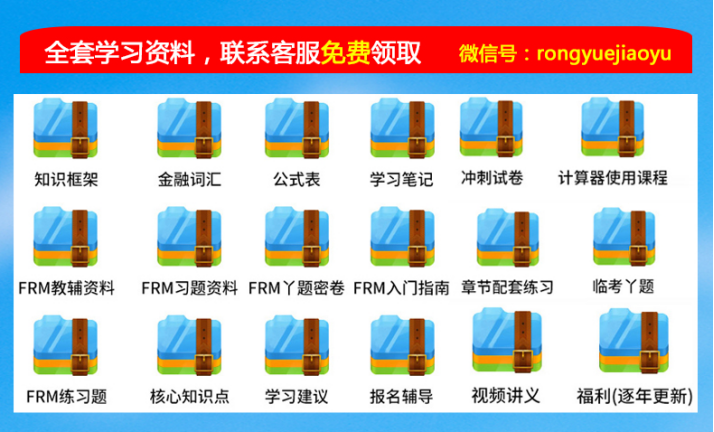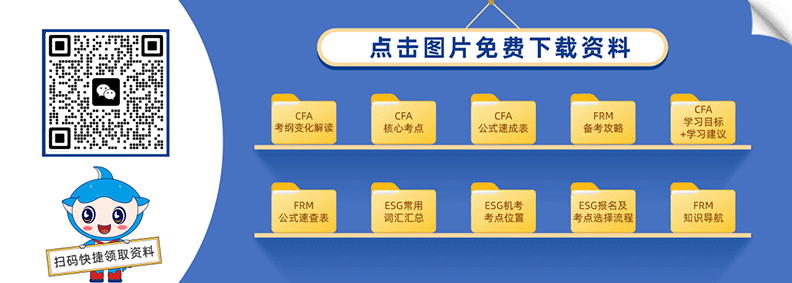Valuation and Risk Models是FRM一级考试内容,即估值与风险建模。在2021年新的考纲中有何变化,下文是详细介绍!>>>点击领取2021年FRM备考资料大礼包(戳我免·费领取)
Valuation and Risk Models(估值与风险建模)在2021年FRM考试中,占比仍然是30%。
从各个章节上来看,考纲没有太大的变化,只是几个别的章节内容略微有所增减。LOS替换部分,没有较大的实质性变化。无新增,有删减和调整!
Valuation and Risk Models(估值与风险建模)考纲变化:
Chapter 1. Measures of Financial Risk
Describe spectral risk measures and explain how VaR and ES are special cases of spectral risk measures.
Chapter 2. Calculating and Applying VaR
Explain the full revaluation method for computing VaR.
Compare delta-normal and full revaluation approaches for computing VaR.
Chapter 3. Measuring and Monitoring Volatility
Evaluate the various approaches for estimating VaR.
Chapter 8. Stress Testing
Describe the key elements of effective governance over stress testing.
Describe the important role of the internal audit in stress testing governance and control.
Chapter 13. Modeling Non-Parallel Term Structure Shifts and Hedging
Describe and assess the major weakness attributable to single-factor approaches when hedging portfolios or implementing asset liability techniques.
Describe the key rate exposure technique in multi-factor hedging applications; summarize its advantages and disadvantages.
替换
Chapter 2. Calculating and Applying VaR
Explain the structured Monte Carlo method for computing VaR and identify its strengths and weaknesses. (2021)
Explain structured Monte Carlo and stress testing methods for computing VaR and identify strengths and weaknesses of each approach. (2020)
Chapter 4. External and Internal Credit Ratings
Explain and compare the through-the-cycle and point-in-time internal ratings approaches. (2021)
Explain and compare the through-the-cycle and at-the-point internal ratings approaches. (2020)
Describe the relationships between changes in credit ratings and changes in stock prices, bond prices, and credit default swap spreads. (2021)
Explain the potential impact of ratings changes on bond and stock prices. (2020)
Chapter 7. Operational Risk
Explain how the moral hazard and adverse selection problems faced by insurance companies relate to insurance against operational risk. (2021)
Explain the risks of moral hazard and adverse selection when using insurance to mitigate operational risks. (2020)
Chapter 8. Stress Testing
Explain key considerations and challenges related to stress testing, including choice of scenarios, regulatory specifications, model building, and reverse stress testing. (2021)
Identify key aspects of stress testing governance, including choice of scenarios, regulatory specifications, model building, stress-testing coverage, capital and liquidity stress testing and reverse stress testing. (2020)
Describe stressed VaR and stressed ES and compare the process of determining stressed VaR and ES to that of traditional VaR and ES. (2021)
Explain the importance of stressed inputs and their importance in stressed VaR and stressed ES. (2020)
Describe the responsibilities of the board of directors, senior management, and the internal audit function in stress testing governance. (2021)
Describe the responsibilities of the board of directors and senior management in stress testing activities. (2020)
Chapter 10. Interest Rates
Define spot rate and compute discount factors given spot rates. (2021)
Define spot rate and compute spot rates given discount factors. (2020)
Chapter 13. Modeling Non-Parallel Term Structure Shifts and Hedging
Compute the positions in hedging instruments necessary to hedge the key rate risks of a portfolio. (2021)
Calculate the key rate exposures for a given security and compute the appropriate hedging positions given a specific key rate exposure profile. (2020)
- 报考条件
- 报名时间
- 报名费用
- 考试科目
- 考试时间
-
GARP对于FRM报考条件的规定:
What qualifications do I need to register for the FRM Program?
There are no educational or professional prerequisites needed toregister.
翻译为:报名FRM考试没有任何学历或专业的先决条件。
可以理解为,报名FRM考试没有任何的学历和专业的要求,只要是你想考,都可以报名的。查看完整内容 -
2024年5月FRM考试报名时间为:
早鸟价报名阶段:2023年12月1日-2024年1月31日。
标准价报名阶段:2024年2月1日-2024年3月31日。2024年8月FRM考试报名时间为:
早鸟价报名阶段:2024年3月1日-2024年4月30日。
标准价报名阶段:2024年5月1日-2024年6月30日。2024年11月FRM考试报名时间为:
早鸟价报名时间:2024年5月1日-2024年7月31日。
标准价报名时间:2024年8月1日-2024年9月30日。查看完整内容 -
2023年GARP协会对FRM的各级考试报名的费用作出了修改:将原先早报阶段考试费从$550上涨至$600,标准阶段考试费从$750上涨至$800。费用分为:
注册费:$ 400 USD;
考试费:$ 600 USD(第一阶段)or $ 800 USD(第二阶段);
场地费:$ 40 USD(大陆考生每次参加FRM考试都需缴纳场地费);
数据费:$ 10 USD(只收取一次);
首次注册的考生费用为(注册费 + 考试费 + 场地费 + 数据费)= $1050 or $1250 USD。
非首次注册的考生费用为(考试费 + 场地费) = $640 or $840 USD。查看完整内容 -
FRM考试共两级,FRM一级四门科目,FRM二级六门科目;具体科目及占比如下:
FRM一级(共四门科目)
1、Foundations of Risk Management风险管理基础(大约占20%)
2、Quantitative Analysis数量分析(大约占20%)
3、Valuation and Risk Models估值与风险建模(大约占30%)
4、Financial Markets and Products金融市场与金融产品(大约占30%)
FRM二级(共六门科目)
1、Market Risk Measurement and Management市场风险管理与测量(大约占20%)
2、Credit Risk Measurement and Management信用风险管理与测量(大约占20%)
3、Operational and Integrated Risk Management操作及综合风险管理(大约占20%)
4、Liquidity and Treasury Risk Measurement and Management 流动性风险管理(大约占15%)
5、Risk Management and Investment Management投资风险管理(大约占15%)
6、Current Issues in Financial Markets金融市场前沿话题(大约占10%)查看完整内容 -
2024年FRM考试时间安排如下:
FRM一级考试:
2024年5月4日-5月17日;
2024年8月3日(周六)上午;
2024年11月2日-11月15日。FRM二级考试:
2024年5月18日-5月24日;
2024年8月3月(周六)下午;
2024年11月16日-11月22日。查看完整内容
-
中文名
金融风险管理师
-
持证人数
25000(中国)
-
外文名
FRM(Financial Risk Manager)
-
考试等级
FRM考试共分为两级考试
-
考试时间
5月、8月、11月
-
报名时间
5月考试(12月1日-3月31日)
8月考试(3月1日-6月30日)
11月考试(5月1日-9月30日)










